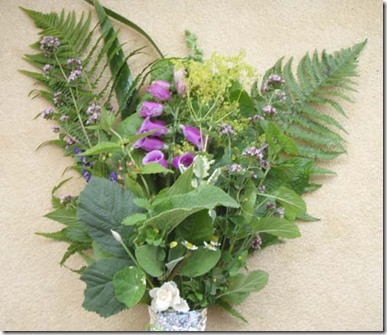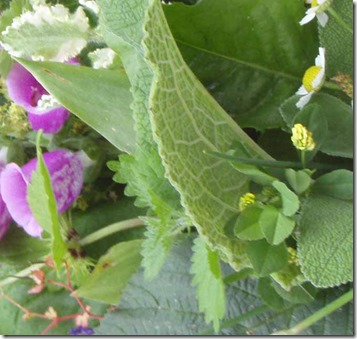I’ve had a fascinating couple of weeks searching my garden for herbs. It all began when I saw that among the schedule of classes for this year’s Country Show at Thornton Rust was a “bunch of mixed herbs with a list of names” and they had to come from one’s own garden.
At first I felt a bit sad because my parsley had disappeared, my nasturtiums had taken one look at my garden and decided on a “go slow”, and my rosemary bush had died a few years ago. I have one of those gardens in which plants either seed themselves and grow like weeds (like the violas) or make a quick, ungracious exit.
But this year the pineapple mint has decided to fight the violas for space – and the spearmint is as invasive as ever. In addition I do have apple mint, marjoram, lemon balm and chives. And aren’t stinging nettles a herb?
So I turned to the Collins Gem Guide on Herbs for Cooking and Health written by Christine Grey-Wilson. Suddenly a whole world of herbs opened up and some of the lowliest weeds became little treasures.
I ended up with a bunch of 26 herbs. Somewhat amazed I checked the Oxford Dictionary to make sure I had got it right. The definition given there is: Herb – any plant with leaves, seeds or flowers which can be used for flavouring, food, medicine or perfume.
Here’s my list:
Blackberry – has medicinal uses besides having nice fruit to eat.
Chives
Clover – leaves and flowers of the white clover can be used in salads
Dandelion – can be used for medicinal purposes, and the young leaves can be put in salads or in soups. You can even dry, roast and grind the roots to make a coffee-like drink.
Deadnettle – young leaves as vegetables, or with soapwort to make a shampoo
English Lavender
Feverfew – infuse as a hot bath to alleviate aches and pains… or in a tea for headaches
Fern (Male Fern) – ground dried rhizome as treatment for worms.
Foxglove – digitalis
Goosegrass (Cleavers) – eat as a spring veg or make a broth to cure overweight! Roast fruits ground to make something like coffee.
Herb Robert – dressing for cuts and wounds
Lady’s Mantle – a soothing bath herb, or use the dried leaves ‘to make a useful tea for all female complaints’
Lemon Balm
Lily of the Valley – produces a milder version of digitalis
Mints : Spearmint, Apple mint, Pineapple mint. I infuse apple mint in hot water to make my favourite herbal tea.
Nasturium – can use the leaves in salads and the seeds can be pickled.
Pot Marjoram – that’s definitely becoming a weed in my garden and the bees love it.
Rhubarb – originally grown for its ‘mild astringent and purgative actions’
Rough Comfrey – Comfrey oil is used to heal bruises, and pulled muscles and ligaments etc
Sage
Stinging Nettle – ‘tops are delicious as a vegetable and in soups’ (wrapped in a foxglove leaf – see below)
Yellow Flag – seeds once used for a drink similar to coffee. Roots used to make black dye, flowers for yellow dye
Yellow hopclover – good source of protein. Flowers and leaves can be eaten raw, drunk as tea, or the flower heads can be dried and ground into a nutritious flour.
Plaintain – medicinal uses as antibacterial and anti-inflammatory. Leaves and seed heads can be dried for tea. Young leaves can be used in salads.

